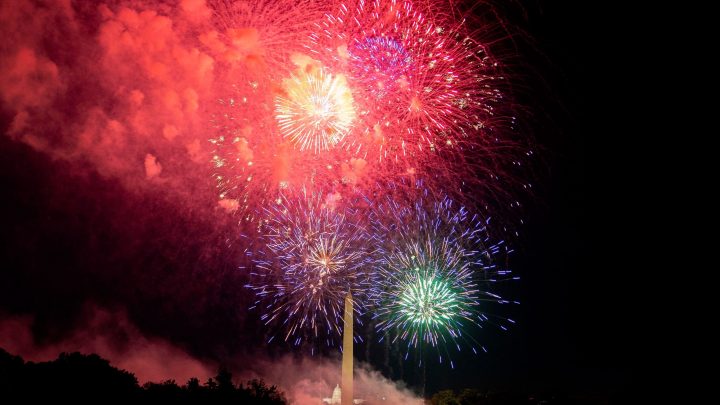
Fireworks, by the numbers

On Tuesday, July 4, millions of Americans will celebrate Independence Day with food, family and fireworks. This year’s date marks the 247th anniversary of the Declaration of Independence, and if the upward trend in fireworks consumption continues, it’s sure to be an explosive holiday.
But first, let’s get the record straight on which kind of fireworks people are buying. The American Pyrotechnics Association separates its data on fireworks into two parts: consumer fireworks, which are fireworks sold to the public, and display fireworks, which are fireworks sold to professionals for large shows. Consumer fireworks have a legal limit of 50mg of explosive material per individual firework.
In 2022, the United States fireworks industry made $400 million in display fireworks revenue and $2.3 billion in consumer fireworks revenue, according to the APA. This has grown a lot from the $203 million and $407 million, respectively, that the fireworks industry made in the year 2000.
Along with revenue, fireworks consumption has also grown over the last few decades. Total fireworks consumption last year was 461.7 million pounds, broken up into 436.4 million pounds of consumer fireworks and 25.3 million pounds of display fireworks. Compare that to the 102 million pounds of consumer fireworks and 50.6 million pounds of display fireworks consumed in 2000. The fireworks business is booming — literally.
The APA’s data showed a huge jump in fireworks consumption between 2019 and 2020, going from 273.0 million pounds to 404.5 million pounds. The consumer fireworks consumption (the main source of the gain, as display fireworks consumption dipped) saw an “average reported increase … [of] an unprecedented 55% as compared to 2019 consumption.” That might explain the rise in fireworks complaints that emergency departments faced in the midst of the pandemic lockdowns.
Fireworks laws can differ from state-to-state or even within states, so you’ll need to check your local laws before lighting up. 47 states and Washington, D.C. allow “some or all types of consumer fireworks,” according to the APA, and each state has their own restrictions on firework types. Two states, Illinois and Vermont, only allow sparklers and “novelty items.”
And that leaves Massachusetts, the one state in which all consumer fireworks are banned. Residents who use fireworks can be fined from $10 to $100 and have their fireworks seized, plus potentially face the ire of their neighbors. If you sell fireworks, you could be fined $100 to $1,000 or go to jail for a maximum of one year (or both).
Part of Massachusetts’ reasoning is based on potential injuries from fireworks, which is a fair concern. The APA estimated that there were 10,163 fireworks-related injuries in 2022. The United States Consumer Product Safety Commission’s 2022 report found that 3.1 per 100,000 people in the United States had fireworks-related injuries and received treatment.
Instead of comparing injury numbers to the United States population, the APA compared injury numbers to the amount of fireworks consumed, finding a rate of 2.2 injuries per 100,000 pounds of fireworks consumed in 2022.
The United States Consumer Product Safety Commission also did a one-month special study in 2022 and discovered that about 73% of fireworks injuries where the victims sought emergency medical treatment in 2022 happened between June 17 and July 17. The most common body parts to be injured by fireworks were of course hands and fingers, which made up about 29% of all injuries.
Aside from injuries — and the noise and pet disturbances, another risk factor of lighting things on fire is, well, fires. The National Fire Protection Association estimated that in 2021, fireworks sparked 12,264 fires that went on to cause $59 million in direct property damage.
Just as fireworks laws differ by location, so too does the age at which you can legally buy fireworks. In Arkansas, Mississippi, North Dakota and Oklahoma, you only have to be 12 years old to buy fireworks, every kid’s dream and every parent’s nightmare. Wisconsin has no age restriction on sparklers and other small devices that can be bought without a permit, as the state’s fireworks law does not see these devices as “fireworks.” Tough luck if you’re in New Hampshire or Maine — you’ll have to be 21 years old.
Not to worry, though — if you’re living in Massachusetts and want to get your fireworks fix, you can check out one of the 23 professional fireworks displays held throughout the state on July 4.
Can’t get out to watch fireworks in-person? Macy’s 47th annual Fourth of July Fireworks show in New York will be televised. The show consists of 60,000 total fireworks shells, and Macy’s says that fireworks shells and effects will be launched at a rate of 2,400 per minute.
And if you’re setting some off yourself, please, don’t set them off all night long. Your neighbors and their pets will thank you.
There’s a lot happening in the world. Through it all, Marketplace is here for you.
You rely on Marketplace to break down the world’s events and tell you how it affects you in a fact-based, approachable way. We rely on your financial support to keep making that possible.
Your donation today powers the independent journalism that you rely on. For just $5/month, you can help sustain Marketplace so we can keep reporting on the things that matter to you.


















